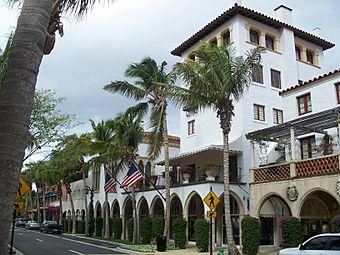Via Mizner facts for kids
Quick facts for kids |
|
|
Via Mizner
|
|
 |
|
| Location | Palm Beach, Florida |
|---|---|
| Architectural style | Mission/Spanish Revival |
| NRHP reference No. | 93000256 |
| Added to NRHP | April 1st, 1993 |
The Via Mizner is a famous historic place in Palm Beach, Florida. It's like a special path or street located at 337–339 Worth Avenue. On April 1, 1993, it became part of the U.S. National Register of Historic Places, which means it's an important historical site.
Contents
What is Via Mizner?
A "via" is a Latin word that means "way" or "path." Think of it as a small, winding street or a channel. Via Mizner is about 85 yards long. It connects Worth Avenue, a main shopping street in Palm Beach, to Peruvian Avenue.
Who Created Via Mizner?
The Via Mizner was created in 1923 by a very creative architect named Addison Mizner. He had already finished a big project called the Everglades Club in 1918. Via Mizner is right across from this club.
Addison Mizner wanted to create a special place. He was inspired by old Spanish castles. These castles often had "inner cities" inside their walls. These areas later became places for shops and businesses. Mizner said these spaces usually faced small, winding streets. They were open to people walking along narrow paths.
A Special Kind of Architecture
Mizner wanted to make Via Mizner feel like a European village. It has charming and unique buildings. These buildings hold shops, offices, and homes. Via Mizner mixes different styles. It has Mediterranean Revival and Spanish Colonial Revival architecture. It also has a touch of old Venice. All of this is made to fit Florida's warm climate.
The roofs are made of red terracotta tiles. The walls are white stucco. They have many windows of different shapes. You can see wooden balconies and special wood accents. There are also decorative iron details. The stairs leading to the homes have colorful ceramic tiles. Palm trees remind everyone of the tropical setting.
A Unique Shopping Experience
Before big shopping malls existed, Via Mizner offered a unique experience. People could walk outside and enjoy the fresh air. They could shop in small stores and art galleries. It felt welcoming and not too commercial.
Via Mizner's special look quickly became famous in Palm Beach. Over the years, many other architects and designers have copied Mizner's unique style. You can see his influence all over Florida today.
Villa Mizner: Addison's Home
Via Mizner has twenty well-known shops and businesses. It also has some apartments. The most famous address is 1, Via Mizner. This was Addison Mizner's own grand home. It's a five-story, tower-like building called Villa Mizner.
Mizner designed the top floor as one big room. He used it as his office. This office has sixteen windows. They look out over the entire island of Palm Beach. Mizner's pet monkey, named Johnny Brown, is buried at the bottom of his living room. The living room is quite large, about 35 by 40 feet.
Via Mizner still looks today exactly as Addison Mizner imagined it.



